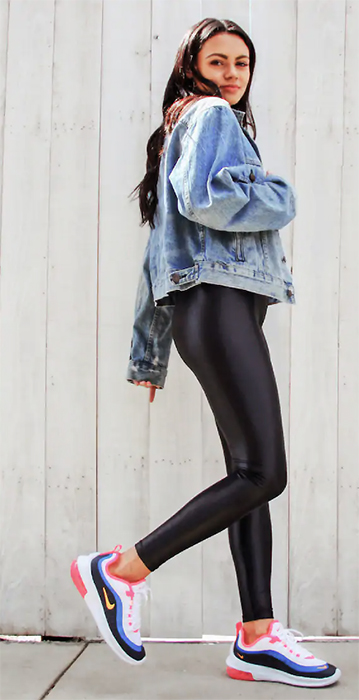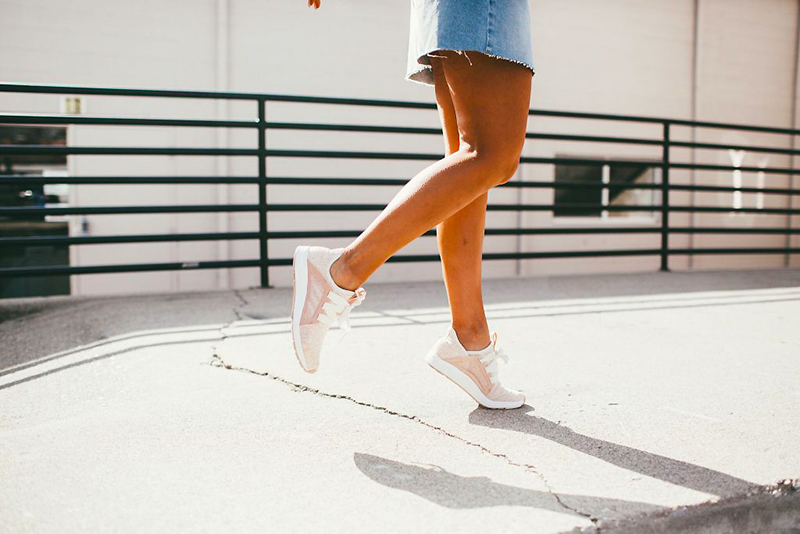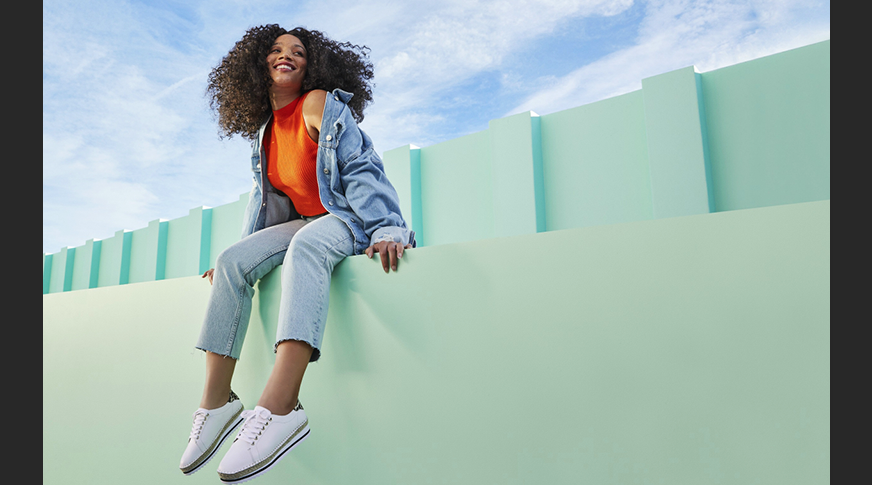DSW’s strong pivot toward athleisure over the last year has made the off-price chain the second-largest retailer of women’s athleisure in the U.S. behind only Nike, said Roger Rawlins, CEO of Designer Brands, DSW’s parent, on his company’s third-quarter analyst conference call. But that wasn’t enough to offset DSW’s exposure to dressier looks that remain out of fashion amid the pandemic.
DSW’s comps were down 31.9 percent during the third quarter ended November 2 versus flat last year. The comp performance marked sequential improvement from a decline of 44.9 percent in the second quarter with accelerated arrivals of athleisure products, but it wasn’t enough to offset the weakness in dress and seasonal categories and an overall 38 percent decline in store traffic.
Athletic and the broader athleisure categories produced positive comps while dress and seasonal categories comped negative 60 percent and negative 44 percent respectively, reflecting the continuation of depressed consumer demand for footwear supporting social occasions.

Athleisure Expands To 49 Percent Of DSW’s Mix
Rawlins highlighted the success DSW, its U.S. retail segment, is having adding athleisure assortments. He noted that DSW accelerated the shift in 2019 as the athleisure category, defined as athletic products and footwear inspired by athletic looks that are suitable for wearing outside of the gym, represented 52 percent of all footwear sold in the U.S. for women’s and men’s in 2019. In that same time period, only 32 percent of DSW sales were women’s and men’s athleisure footwear.
Rawlins noted that athletic vendors had expressed a desire to partner with retailers who have a substantial market share with the female athlete, leading omnichannel capabilities and the ability to sell both footwear and apparel over the past few years.
“When we met with these partners back in 2019, we emphasized our market share position and award-winning omnichannel capabilities. They listened, and we began our move toward including more athletic fashion in our assortment,” said Rawlins. “When the pandemic hit, the consumer’s desire for this type of product accelerated, and our competitors who have a history of playing more heavily in this space have reaped the benefits. Likewise, as consumers have focused on this athleisure look, our pivot is paying off.”
By the end of the third quarter, DSW had grown its adult athleisure department to 49 percent of sales, well above DSW’s seasonal penetration of 28 percent, which historically has been a much larger percentage of the business.
Athletic penetration at DSW has increased to 26 percent at the end of the third quarter, up from 17 percent last year.
The shift is paying off with athletic comps at DSW up 5 percent in the quarter, significantly better than the 40 percent drop in non-athletic comps. Margins in the athletic category were also strong, up roughly 300 basis points versus last year, while non-athletic was down over 600 basis points.
Other merchandise priorities for DSW include expanding kids, which has grown 10 percent of DSW’s mix from 7 percent last year. Kids comps were roughly flat in the third quarter to strongly outpace the overall comp and delivered improved margins.
An overall focus for DSW emphasizes footwear’s Top 50 brands and, in particular, the Top 10 brands due to consumers’ increased trust in brands. Rawlins said that based on Designer Brands’ research, consumers continue to search for brands first, then a specific type of shoe. For DSW, the Top 50 brands of footwear comprised 73 percent of its total assortment in Q3 compared to 65 percent last year, while the Top 10 brands represented 38 percent, up from 32 percent last year.
On the profitability side, Rawlins highlighted said that DSW’s efforts to reduce inventory exposure and focus on athletic, kids, and the Top 50 brands in footwear contributed to overall merchandise gross margin rate for its U.S. retail business improving 100 basis points when compared to the same period in 2019.
“Clearly, the additional opportunity exists as we increase our men’s and women’s athletic penetration even further and drive incremental purchases for children and other family members,” said Rawlins. “Looking ahead, we’re continuing our aggressive increases in athletic penetration and currently have access to the highest level of inventory possible based on the product made available to us so far by the top national brands.”

Athleisure Momentum Expected To Continue At DSW In 2021
For in the first half of 2021, Rawlins said Designer Brands expects DSW’s athleisure comps to grow double-digits as the current footwear trends are expected to continue into the first half of next year.
Designer Brands is remaining conservative with buys for spring and is working on establishing new measures to increase flexibility around vendor orders should the market normalize quicker than expected and demand for dress and seasonal footwear sees a rebound.
“In the short term, we plan to keep pivoting our assortment to align with consumer preferences,” said Rawlins. “Long term, there will be a day that our customers feel comfortable going out to shows, church and social events. When that time comes, we believe designer brands will be positioned to serve their needs better than any other footwear retailer.”
Companywide, net sales decreased 30.1 percent to $652.9 million in the third quarter. Results came in below Wall Street’s consensus estimate had been $667.27 million. The sales rate improved versus the 42.8 percent decline seen in the second quarter. Companywide comparable sales decreased 30.4 percent for the latest quarter.
In its other segments outside DSW’s U.S. operations, sales in the Canadian retail segment were down 19 percent. The relatively better performance versus DSW was attributed to higher athleisure penetration. Other banners include The Shoe Company and Shoe Warehouse.
In its third segment, Camuto Group, which has heavy exposure to the dress footwear category, wholesale sales declined 37 percent. The Camuto Group segment has been aggressively reducing production to better balance inventories to demand. Brands in the Camuto Group include Jessica Simpson, Lucky Brand, Max Studio, Vince Camuto, and Louise et Cie.
Companywide gross margins eroded to 25.4 percent from 29.3 percent due to a significant reduction in customer traffic, continued elevated markdown activity and increased shipping expenses. Reported operating expenses were down 8.8 percent but increased as a percent of sales to 30.1 percent from last year’s level of 23.1 percent due to a significantly lower sales volume.
Reported net loss was $40.6 million, or 56 cents, including net charges of 30 cents a share primarily related to impairment charges. The adjusted net loss was $19.0 million, or 26 cents loss per diluted share. Results topped Wall Street’s consensus estimate calling for a loss of 42 cents. The adjusted EPS also marked improvement versus the adjusted loss of $1.28 seen in the second quarter.
Inventories Reduced 19 Percent
Inventories were down 19 percent year-over-year, primarily due to strong inventory controls and higher inventory reserves versus the prior year.
For the fourth quarter, Designer Brands did not provide guidance but noted that quarter-to-date comps at its core U.S. retail business, DSW, were down 20 percent.
Rawlins said DSW had seen improved store traffic in August and September but has since seen “significant reversals” in line with the resurgence of COVID-19 cases across the country. Traffic has returned to down in the 40 percent range with major urban centers being hit harder. Rawlins said if COVID-19 resurgence “holds steady, or worsens,” in the fourth quarter, further markdowns may be necessary to clear seasonal boot product that had initially been bought following initial signs of improving demand.
Rawlins concluded, “We will continue to lean into athleisure trends and our liquidity position gives us the flexibility to continue operating in this difficult environment. We do remain hopeful based on the latest information surrounding vaccine trials, but given it will take time for broader distribution, we do not estimate to return to normalize customer behavior or profitability for our company until the back-to-school season of 2021.”
Photos courtesy DSW
















